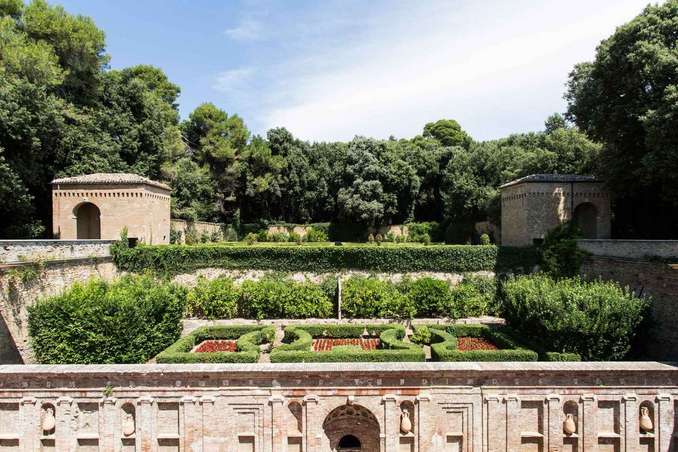
31 August 2018
Villa Imperiale: a jewel set between land and sea
The Villa Imperiale is located a few kilometers from Pesaro, surrounded by the green hills of the Colle San Bartolo Natural Park, that preserves the original relationship between the Villa and the landscape.
The Villa, originally conceived in the 15th century as a Sforza manor, was enlarged and frescoed in the 16th century by the will of the Della Rovere dukes. The end of the dinasty caused a long period of decay, which lasted from 1631 to the 19th century, when the Villa became owned by the Albani family, related to the Castelbarcos.
The Villa Imperiale looks still today as the perfect image of an ancient suburban villa where landscape and architecture find their right balance. From its origins, the Villa was the scene of the court ceremonies and celebrations, and it preserves still today its original vocation for hospitality. The complex consists of two very different buildings, linked by a hanging corridor: the fifteenth-century villa of the Sforza, former lords of Pesaro, and the sixteenth-century wing designed by the architect Girolamo Genga for the Della Rovere dukes. As declaimed by the inscription composed by Bembo and posted on the sixteenth-century facade, the Villa Imperiale in Pesaro was conceived by the duchess Leonora as a gift to the duke Francesco Maria I, who would have found there rest and leisure after the hardships suffered at war. The new wing, nestled on the hill and organised by a system of terraces, is characterised by a predominance of open spaces: loggias, gardens and courtyards, all designed for the leisure of the dukes and their guests. Gardens and architecture are two inseparable elements in the Villa Imperiale: the former, like the masonry architecture, are characterised by a gradual sequence of spaces and by a continuous discovery of them; a sort of “promenade architecturale” that culminates on the top terrace. Here one can admire the natural landscape towards the valley, being at the same time immersed in the wild nature of the woods that surround the villa.
The Villa, originally conceived in the 15th century as a Sforza manor, was enlarged and frescoed in the 16th century by the will of the Della Rovere dukes. The end of the dinasty caused a long period of decay, which lasted from 1631 to the 19th century, when the Villa became owned by the Albani family, related to the Castelbarcos.
The Villa Imperiale looks still today as the perfect image of an ancient suburban villa where landscape and architecture find their right balance. From its origins, the Villa was the scene of the court ceremonies and celebrations, and it preserves still today its original vocation for hospitality. The complex consists of two very different buildings, linked by a hanging corridor: the fifteenth-century villa of the Sforza, former lords of Pesaro, and the sixteenth-century wing designed by the architect Girolamo Genga for the Della Rovere dukes. As declaimed by the inscription composed by Bembo and posted on the sixteenth-century facade, the Villa Imperiale in Pesaro was conceived by the duchess Leonora as a gift to the duke Francesco Maria I, who would have found there rest and leisure after the hardships suffered at war. The new wing, nestled on the hill and organised by a system of terraces, is characterised by a predominance of open spaces: loggias, gardens and courtyards, all designed for the leisure of the dukes and their guests. Gardens and architecture are two inseparable elements in the Villa Imperiale: the former, like the masonry architecture, are characterised by a gradual sequence of spaces and by a continuous discovery of them; a sort of “promenade architecturale” that culminates on the top terrace. Here one can admire the natural landscape towards the valley, being at the same time immersed in the wild nature of the woods that surround the villa.
Give me odorous at sunrise a garden of beautiful flowers where I can walk undisturbed- Walt Whitman - |






